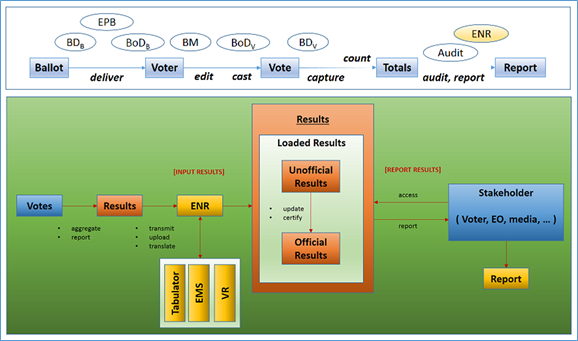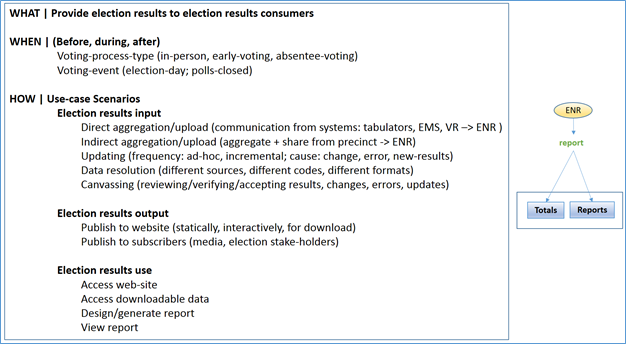Election Night Reporting (ENR) Use Case
READ-ONLY SITE MATERIALS: Historical voting TWiki site (2015-2020) ARCHIVED from https://collaborate.nist.gov/voting/bin/view/Voting

The primary purpose of election-night reporting (ENR) is to provide election results to election results consumers (election stakeholders, voters, public, media, and others). Election results represent the total counted votes from each reporting context (precincts, county, etc.) exercised in a state. An ENR tool generally operates from the highest-level reporting context (e.g., state or county). Results may reach the ENR in many possible ways depending on the election processing (distributed, centralized), dominant voting type (absentee only vs. mixture), state laws (deadlines for accepting/processing absentee, provisional ballot types), reporting abilities they are designed to support (incremental, batch; before, during, after election/polls-closed). Typically, initial uploads of results (by EOs) are provided to the ENR and may be updated as additional results or corrected errors are processed. ENR tools may provide users with overall results process completion information indicating what results have been received, are complete, and so forth. Results are finalized and certified after official canvassing which reviews unofficial results after all are loaded and any corrections are made. ENR tools involve the coordination of a number of factors affecting their operation and implementation. They must be prepared to process and provide data accurately, securely, and without loss of service throughout the entire reporting process and under heavy upload or access periods. They must be able to receive, resolve, integrate and manage results data with respect to a number of different sources (systems: tabulator, EMS, VR; reporting-contexts: precinct, county), transport methods (physical; logical/remote: modem, wired, wireless), data formats (CDF, XML, CSV, …), codings (contest, county), and destinations (published web, data subscribers: media, stake-holders). All throughout the security, integrity, and reliability of the data and process should be maintained. ENR implementations may exist standalone or may be embedded inside other systems (such as an EMS). They may also access other systems to obtain results data or context data (such as voter turnout, voter-specific information from a VR system). They may be implemented using a variety of architectures and approaches ranging from standalone, on-site systems to distributed, cloud-based solutions. In all cases, at minimum, they enable users to generate reports per reporting context. Beyond that, many other data interaction, filtering, interpretation, and reporting options are available. Data formats may be used both on the input and output sides, enabling both results input/uploading as well as results access/download via specific formats.

Use Case Scenarios
WHAT | Provide election results to election results consumers
WHEN | (Before, during, after)
-
Voting-process-type (in-person, early-voting, absentee-voting)
-
Voting-event (election-day; polls-closed)
HOW | Scenarios
-
Election results input
-
Direct aggregation/upload (communication from systems: tabulators, EMS, VR -> ENR)
-
Indirect aggregation/upload (aggregate + share from precinct --> ENR)
-
Updating (frequency: ad-hoc, incremental; cause: change, error, new-results)
-
Data resolution (different sources, different codes, different formats)
-
Canvassing (reviewing/verifying/accepting results, changes, errors, updates)
-
-
Election results output
-
Publish to website (statically, interactively, for download)
-
Publish to subscribers (media, election stake-holders)
-
-
Election results use
-
Access web-site
-
Access downloadable data
-
Design/generate report
-
View report
-
Request for Feedback
For each use case scenario, please address these questions:
- Is the use case scenario in scope for the Next Generation VVSG for development of requirements that will undergo testing and certification? or
- Is the use case scenario in scope to develop as guidelines for election officials and voting system manufacturers? or
- Is the use case scenario not in scope for this work?
- If different parts of the use case scenario fall in 1., 2., and/or 3. Please identify as such.
- Is anything missing?
Voting TWiki Archive (2015-2020): read-only, archived wiki site, National Institute of Standards and Technology (NIST)
ARCHIVE SITE DESCRIPTION AND DISCLAIMER
This page, and related pages, represent archived materials (pages, documents, links, and content) that were produced and/or provided by members of public working groups engaged in collaborative activities to support the development of the Voluntary Voting System Guidelines (VVSG) 2.0. These TWiki activities began in 2015 and continued until early 2020. During that time period, this content was hosted on a Voting TWiki site. That TWiki site was decommissioned in 2020 due to technology migration needs. The TWiki activities that generated this content ceased to operate actively through the TWiki at the time the draft VVSG 2.0 was released, in February of 2020. The historical pages and documents produced there have been archived now in read-only, static form.
- The archived materials of this TWiki (including pages, documents, links, content) are provided for historical purposes only.
- They are not actively maintained.
- They are provided "as is" as a public service.
- They represent the "work in progress" efforts of a community of volunteer members of public working groups collaborating from late 2015 to February of 2020.
- These archived materials do not necessarily represent official or peer-reviewed NIST documents nor do they necessarily represent official views or statements of NIST.
- Unless otherwise stated these materials should be treated as historical, pre-decisional, artifacts of public working group activities only.
- NIST MAKES NO WARRANTY OF ANY KIND, EXPRESS, IMPLIED OR STATUTORY, INCLUDING, WITHOUT LIMITATION, THE IMPLIED WARRANTY OF MERCHANTABILITY, FITNESS FOR A PARTICULAR PURPOSE, NON-INFRINGEMENT AND DATA ACCURACY.
- NIST does not warrant or make any representations regarding the correctness, accuracy, reliability or usefulness of the archived materials.
ARCHIVED VOTING TWIKI SITE MATERIALS
This wiki was a collaborative website. NIST does not necessarily endorse the views expressed, or concur with the facts presented on these archived TWiki materials. Further, NIST does not endorse any commercial products that may be mentioned in these materials. Archived material on this TWiki site is made available to interested parties for informational and research purposes. Materials were contributed by Participants with the understanding that all contributed material would be publicly available. Contributions were made by Participants with the understanding that that no copyright or patent right shall be deemed to have been waived by such contribution or disclosure. Any data or information provided is for illustrative purposes only, and does not imply a validation of results by NIST. By selecting external links, users of these materials will be leaving NIST webspace. Links to other websites were provided because they may have information that would be of interest to readers of this TWiki. No inferences should be drawn on account of other sites being referenced, or not referenced, from this page or these materials. There may be other websites or references that are more appropriate for a particular reader's purpose.

